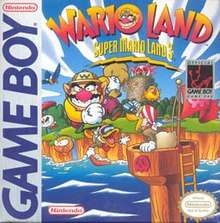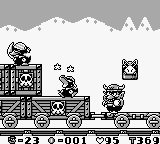Wario Land: Super Mario Land 3
Wario Land: Super Mario Land 3[lower-alpha 1] is a platform game developed by Nintendo for the Game Boy in 1994. It is the first video game to feature Wario as both a playable character and the main character, as well as the first appearance of Captain Syrup and her Brown Sugar Pirates, recurring villains in the Wario Land series.
| Wario Land: Super Mario Land 3 | |
|---|---|
 North American box art | |
| Developer(s) | Nintendo R&D1 |
| Publisher(s) | Nintendo |
| Director(s) | Hiroji Kiyotake Takehiko Hosokawa |
| Producer(s) | Gunpei Yokoi |
| Designer(s) | Hiroji Kiyotake Takehiko Hosokawa Kenichi Sugino |
| Programmer(s) | Masaru Yamanaka Yuguru Ozawa Isao Hirano Yoshinori Katsuki |
| Composer(s) | Ryoji Yoshitomi Kozue Ishikawa |
| Series | Wario |
| Platform(s) | Game Boy, Nintendo 3DS |
| Release | |
| Genre(s) | Platforming |
| Mode(s) | Single-player |
The game was later released for the Nintendo 3DS's Virtual Console service via the Nintendo eShop on which it gained positive reviews from critics.
Gameplay

Wario Land features gameplay markedly different from the previous two games in the Super Mario Land series. The game takes place on a route through several themed areas, which are split into several courses culminating in a boss fight. Wario is able to jump on or bump into enemies to knock them over. Enemies thus stunned can be picked up and thrown at other enemies. When in his grown form, Wario is also able to perform a shoulder charge, which is used to attack enemies, break through blocks and open hidden treasure chests.
There are additionally three unique helmets that Wario can obtain, with their own abilities. The Bull Helmet increases Wario's strength and doubles the length of his shoulder charge attack, allowing him to smash through blocks more easily. It also gives Wario the abilities to stick onto ceilings and perform a "butt stomp" into the ground which stuns nearby enemies and breaks through blocks underneath him. The Jet Helmet increases Wario's running speed and lets him fly in purely horizontal directions in the air, as well as to shoulder charge underwater. Finally, the Dragon Helmet lets Wario shoot long-ranged bursts of flames both on land and underwater, which destroy enemies and blocks on contact. This attack replaces his shoulder charge so long as he wears the Dragon Helmet. Players can also collect a Starman to gain temporary invincibility. If Wario takes damage from an opponent or obstacle, he will shrink, losing his shoulder charge move, and will remain small until he collects a clove of garlic, a helmet, or reaches the end of the level. If Wario is hit while small, or is hit by an instant kill obstacle, such as pits or lava, he will lose a life and all the coins he had collected in that level.
Unlike the Mario series, in which coins are typically used to earn extra lives, coins in this game are instead used as currency. They can be earned by collecting them, finding them in blocks, or shoulder charging enemies. If Wario has acquired 10 or more coins in a level, he can pull out a 10-coin piece, which he can throw at enemies, and pick up again if desired. They can also be spent to open level exits, or activate checkpoints. Extra lives are earned by collecting heart points, which are earned by defeating enemies or collecting Hearts, with an extra life earned for every 100 points. At the end of each level, the player can choose to either gamble the coins they have collected in the level in a game of chance, or spend them to try and earn heart points.
Certain levels contain a locked treasure room, each of which contains a unique treasure. To acquire the treasure the player must find the key in the level, carry it to the treasure room (Wario cannot use helmet abilities or the shoulder charge while carrying the key), break open the treasure chest, take the treasure, and finish the level. Upon finishing the game, each treasure the player has acquired is traded in for a set amount of coins. Even the least valuable treasure is worth roughly as much coins as the player would normally acquire over the entire game. The game's ending varies according to how many total coins the player has.
Plot
After being ejected from Mario's castle in the previous game, Wario resolves to get his own castle, one even bigger and more impressive than Mario's. To fund this extravagant dream, he travels to Kitchen Island, where the Brown Sugar Pirates have hidden many treasures and coins, including a golden statue of Princess Peach, stolen from the Mushroom Kingdom. Wario intends to retrieve this statue and sell it back to Mario for the price of a castle.[1] After exploring the island, stealing the pirates' treasures, and infiltrating their Syrup Castle, Wario confronts the leader of the pirates, a female buccaneer named Captain Syrup. She summons a genie to destroy Wario, but he defeats the genie and Syrup destroys the castle with a large bomb as she escapes. In doing so, the pirates' biggest treasure is revealed: the giant gold statue of Princess Peach. However, Mario appears in a helicopter, thanks Wario and takes the statue away in front of his eyes.
Still holding the genie's lamp, Wario summons the genie and wishes for a castle. The genie tells him that he requires money to grant his wish, and so Wario gives him all the coins the player has collected over the course of the game, plus trades in all the found treasures for more coins. Exactly how well the genie grants Wario's wish depends on the final amount of coins he is given: Wario can get (from best to worst outcome) a castle, a Chinese pagoda, a log cabin, a treehouse, or a tiny birdhouse. If the player collects all the treasures and has enough coins to reach the 99,999 limit, the genie will give Wario an entire planet with his face etched on its surface.
Release
Originally released for the Game Boy on January 21, 1994 in Japan and from March 13 to May 13 in North America and Europe, the game was later re-released on the Nintendo 3DS's eShop Virtual Console download service in Japan on December 14, 2011,[2] Europe on February 16, 2012 and North America on July 26, 2012. The game can be downloaded along with its predecessors, Super Mario Land and Super Mario Land 2: 6 Golden Coins.
Reception
| Reception | ||||||
|---|---|---|---|---|---|---|
| ||||||
Game Informer's Ben Reeves called it the 13th best Game Boy game and called it the most successful spin-off from the Mario series.[4] GamePro named it the best Game Boy game at the 1994 Consumer Electronics Show, praising the new power-ups and the multiple endings.[5] In their later review, they deemed the game "faster, more challenging, and more fun than its hand-held predecessors." They particularly commented that the backgrounds were not as cluttered as in the previous games, making the action easier to follow, that the music was less obtrusive, and that the sprites were better detailed.[6] The four reviewers of Electronic Gaming Monthly gave it a unanimous 7 out of 10, criticizing that the game is too easy but praising the new power-ups and strong graphics.[7] Pocket Gamer awarded the Virtual Console re-release a 9 out of 10, insisting that "this is a Nintendo classic that you must play – especially if you never have before."[8] Nintendo Life similarly awarded the game 9 out of 10, praising the game as being "some of the best platforming the Game Boy system has to offer."[9]
Legacy
Wario Land, the sequel to Super Mario Land 2: 6 Golden Coins, was designed to promote Wario to a starring role and expand the Mario universe. Wario Land spawned five popular sequels: Virtual Boy Wario Land, Wario Land II, Wario Land 3, Wario Land 4, and Wario Land: Shake It!. Other Wario titles have been released following the success of Wario Land, including Wario World, Wario: Master of Disguise, and the WarioWare Inc. series.
Several Mario spin-off titles have referenced the original Wario Land. In Picross 2, Wario is depicted wearing his safari helmet that was introduced in this title. Similarly, Wario's Amiibo board map in Mario Party 10 features his safari helmet as a background element. And finally, in Mario Kart 7, Wario's bull transformation appears as a billboard on the Wario Shipyard racetrack. Additionally, the music track of this course is based on the main theme of Wario Land.
Notes
References
- "Basic Information". Wario Land: SML3 (Electronic manual). Nintendo. c. 2012. p. 2.
- Wahlgren, Jon (September 28, 2011). "Wario Land: Super Mario Land 3 Steals an OFLC Rating". Nintendo Life. Archived from the original on January 14, 2012. Retrieved August 1, 2020.
- "Wario Land: Super Mario Land 3". GameRankings. CBS Interactive. Archived from the original on September 24, 2010. Retrieved November 24, 2010.
- Reeves, Ben (June 24, 2011). "The 25 Best Game Boy Games Of All Time". Game Informer. Retrieved December 6, 2013.
- "CES Showstoppers". GamePro. No. 57. International Data Group. April 1994. pp. 74–81.
- "ProReview: Wario Land: Super Mario Land 3". GamePro. No. 59. International Data Group. June 1994. pp. 140–142.
- "Review Crew: Wario Land". Electronic Gaming Monthly. No. 57. EGM Media. April 1994. p. 46.
- Rose, Mike (April 23, 2012). "Wario Land: Super Mario Land 3". Pocket Gamer. Steel Media. Retrieved May 26, 2015.
- Dillard, Corbie (February 17, 2012). "Wario Land: Super Mario Land 3". Nintendo Life. sec. Conclusion. Archived from the original on November 18, 2012. Retrieved August 1, 2020.
External links
- Official website (Japanese)
- Wario Land: Super Mario Land 3 at MobyGames
- Wario Land: Super Mario Land 3 at NinDB
- Wario Land: Super Mario Land 3 on IMDb